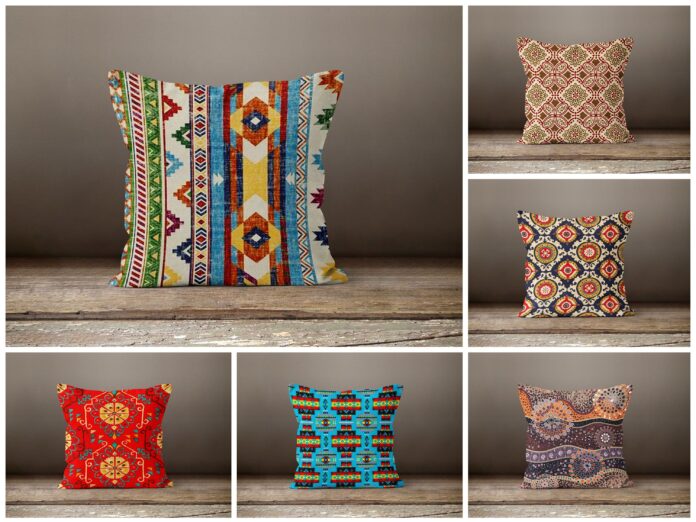The history of ethnic pillows dates back to ancient times when people began to create decorative cushions for both practical and aesthetic purposes. These pillows were often made using local materials and techniques, resulting in unique designs and styles that reflected the culture and traditions of the region. In this blog, we’ll explore the fascinating history of ethnic pillows and how they have evolved over time.
Ancient Times
The use of cushions and pillows dates back to ancient times when people first sought ways to make sitting and sleeping more comfortable. In ancient Egypt, for example, people used headrests made of woven reeds that elevated the head while sleeping. These headrests were also decorated with intricate designs and symbols that reflected the owner’s status and wealth.
In ancient Greece, cushions played an important role in social gatherings like the symposium, where men would recline on couches and engage in intellectual discussions. These cushions were typically made from animal skins and filled with wool or feathers.
Medieval Times
During the medieval period, cushions became even more important as a symbol of luxury and status. Nobles and royalty commissioned elaborate cushions to decorate their homes and castles. These cushions were often made from expensive materials like silk and velvet and embroidered with intricate designs.
In Islamic cultures, cushions were also highly valued and served a practical purpose in daily life. Muslims used cushions called zafu for prayer, meditation, and as a comfortable place to sit on the floor. Zafus were typically made from natural materials like wool and cotton and filled with buckwheat hulls.
Renaissance and Baroque
During the Renaissance and Baroque periods, cushions became even more elaborate and decorative. They were often made in sets and used to decorate entire rooms. These cushions were made from luxurious materials like brocade and velvet and embroidered with intricate designs.
In France, decorative cushions became particularly popular during the reign of Louis XIV. These cushions were often made in pairs and used to decorate the royal apartments at Versailles. They were typically made from silk and embroidered with gold and silver thread.
Modern Times
In the 20th century, ethnic pillows began to take on a new significance as a way to express cultural identity and heritage. People began to create cushions using traditional materials and techniques, resulting in unique and beautiful designs that reflected the diversity of different cultures.
In Africa, for example, cushions were often made using traditional textiles like kente cloth and mud cloth. These cushions were decorated with geometric patterns and bright colors that reflected the vibrant culture of the region.
In Asia, cushions were often made using silk and decorated with intricate embroidery. These cushions were used to decorate homes and were often given as gifts during special occasions like weddings and festivals.
Contemporary Ethnic Pillows
Today, ethnic pillows continue to be popular as a way to express cultural identity and to add a unique touch to home decor. They are often made using traditional materials and techniques, but modern designers are also experimenting with new materials and designs.
In South America, for example, designers are using recycled materials like plastic bottles and packaging to create colorful and unique cushions. These cushions not only showcase the creativity of the designers but also promote sustainable living.
In India, designers are using traditional embroidery techniques to create contemporary designs that appeal to a global audience. These cushions are often made using natural materials like cotton and silk and decorated with vibrant colors and bold patterns.
The Cultural Significance of Ethnic Pillows
Ethnic pillows are more than just decorative objects. They are often deeply intertwined with the cultural heritage and identity of the people who create them. In many cultures, the art of pillow-making is passed down from generation to generation, with each new iteration reflecting the unique aesthetic and style of the maker.
For example, in Mexico, the brightly colored and elaborately decorated pillows called “huipil cushions” are made from traditional huipil garments worn by indigenous women. These cushions not only provide a comfortable place to rest but also serve as a reminder of the rich cultural heritage of the region.
In Turkey, kilim cushions are highly valued for their intricate patterns and symbolism. Kilim is a traditional flat-woven rug that is made using natural fibers like wool and cotton. These rugs are often decorated with geometric patterns and symbols that have deep cultural and religious significance. When kilim is used to make cushions, it adds a touch of cultural heritage to any room.
In some cultures, the art of pillow-making is considered sacred. In Tibet, for example, cushions called zafus are used for meditation and spiritual practice. These cushions are filled with buckwheat hulls and are designed to provide a comfortable and stable seat for meditation. They are often made using traditional textiles and decorated with Buddhist symbols and motifs.
Similarly, in some African cultures, cushions are used to commemorate important life events like weddings and funerals. These African pillows are often made using traditional textiles and decorated with symbolic patterns and colors that represent the significance of the event.
Incorporating Ethnic Pillows into Your Home Decor
If you’re interested in incorporating ethnic pillows into your home decor, there are many ways to do so. One way is to choose pillows that reflect your cultural heritage or personal style. For example, if you’re of Mexican descent, you might choose huipil cushions to add a touch of your cultural heritage to your home.
Another way to incorporate ethnic pillows is to mix and match different styles and patterns. For example, you could pair kilim cushions with Indian block-printed cushions for a global and eclectic look. The key is to choose pillows that complement each other and create a cohesive look.
Finally, consider the placement of your ethnic pillows. Pillows can be used to add color and texture to any room, from the living room to the bedroom. Consider layering pillows of different sizes and shapes on your couch or bed to create a cozy and inviting space.
Conclusion
In conclusion, ethnic pillows have a rich and fascinating history that spans cultures and centuries. From ancient times to today, pillows have played an important role in human comfort and culture. Whether you’re interested in adding a touch of cultural heritage to your home or simply want to add color and texture to your decor, ethnic pillows are a versatile and beautiful addition to any room.



















